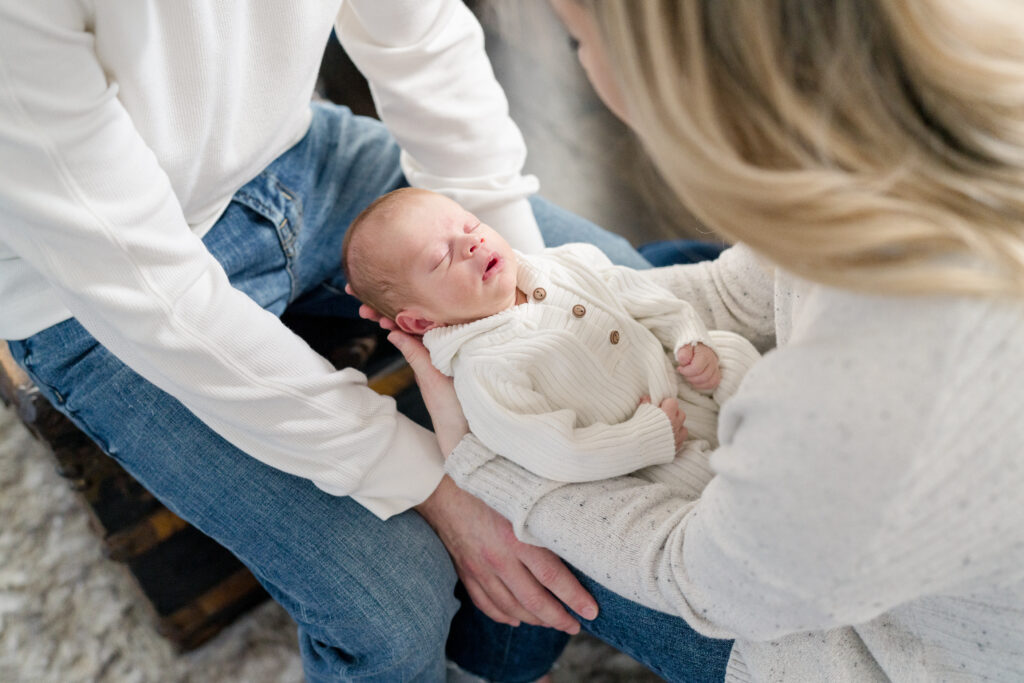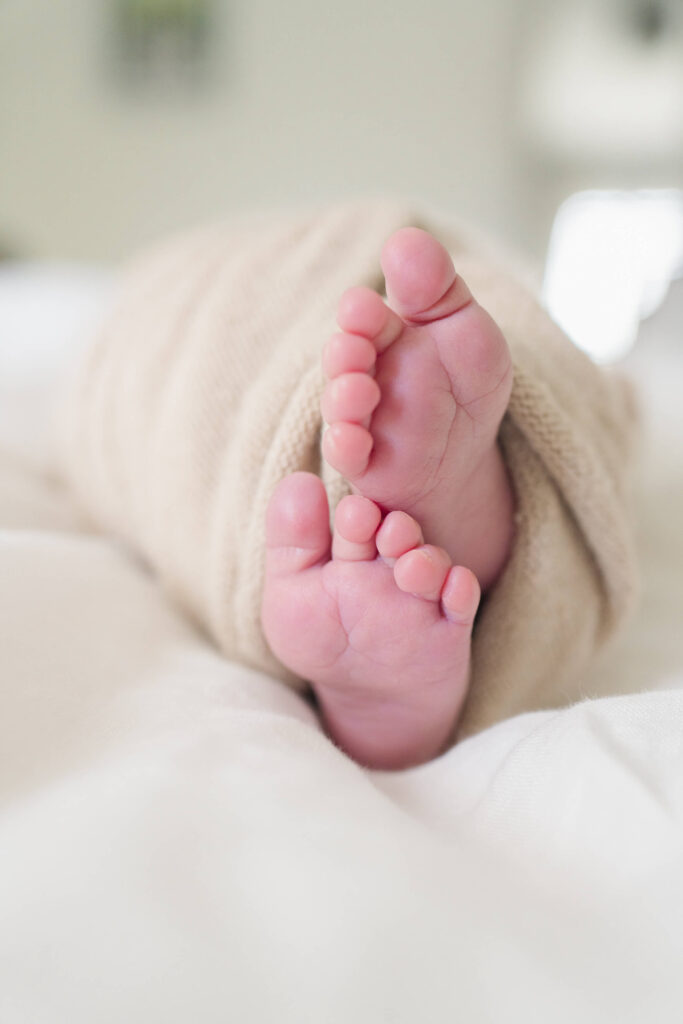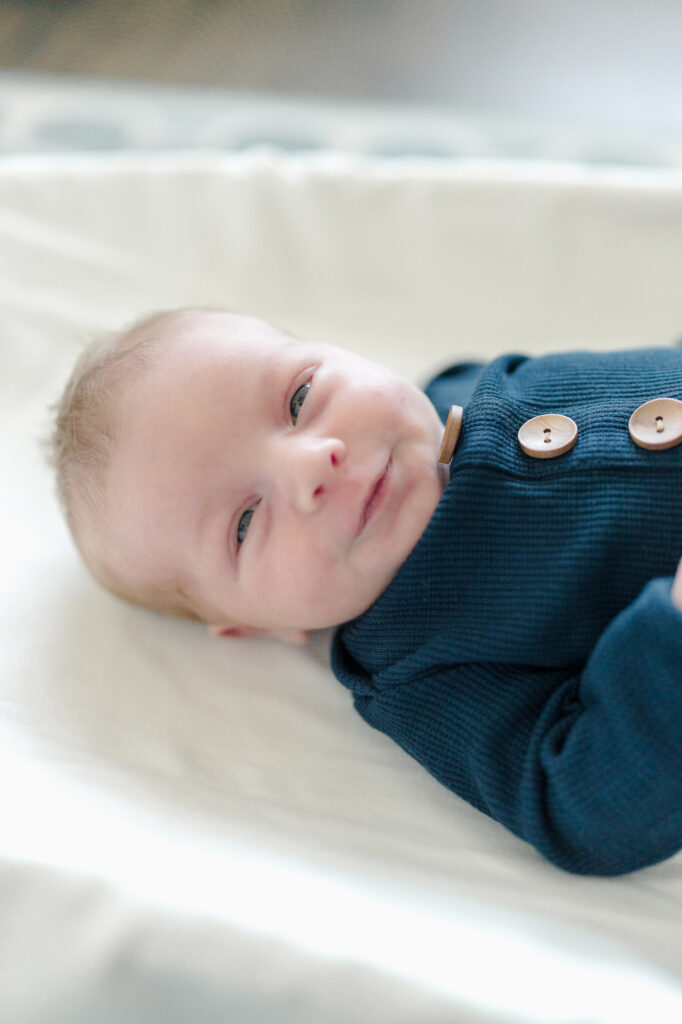How to Prepare for an In-Home Newborn Session
Welcoming a new baby into your family is a joyous occasion, and many parents are eager to capture those first precious memories. Rather than packing everything up and driving to a studio after just giving birth, many families opt instead for the convenience of an in-home newborn session to document their baby’s entrance into the world. It’s much easier to show your family’s love and connection when you’re in a comfortable environment.
Even so, it can feel overwhelming for new parents to prepare for a newborn photo session at home after having a baby. In this blog post, I’ll go over everything you need to know to ensure a stress-free newborn photography experience with beautiful images your family can treasure for generations.
Looking for a NJ newborn photographer?




Preparing Your Home for a Newborn Photo Session
Newborn sessions done from the comfort of your own home allow for a much more personalized and intimate photography experience. Your photographer can document the things that make your family unique, showing the details of your home and the activities you do together. It may not seem important at the time, but these everyday moments will become precious memories that you will cherish for many years to come.
Best rooms for newborn photography
Most families choose the nursery and master bedroom or living room for their newborn pictures. These rooms are naturally where you’ll spend the most time with your new baby.
If you can, send your photographer photos of the room(s) you envision being photographed in ahead of time. Wait until the light is at its brightest, but not directly streaming through the windows creating shadows on the walls or floors.
When your photographer arrives, he or she will do a walkthrough to see which areas of your home get the best natural light. Sometimes the best spots are unexpected, like a door frame, hallway, or staircase.
How to Simplify Your Space for a Photoshoot
The goal is to declutter your home, not to scrub every surface until it shines. Simple, open spaces with a lack of clutter make a much bigger impact on your photos than if there are a few crumbs left on your countertops. Clear off the coffee table or nightstand, make the bed, etc. but don’t worry about vacuuming or dusting every surface. You’ll have just welcomed your baby into your home, there’s no need to add on the stress of making your home look perfect.
Styling the Crib
Put a white crib sheet over the baby mattress so that your newborn has a neutral backdrop for detail shots. Sheets with text, patterns, or bold colors will be distracting, especially for close-up shots. Remove any crib liners ahead of time as well.
Keep Your House Warm
Keeping your home at a warm, comfortable temperature will allow your baby to relax and hopefully sleep. Newborns don’t like to be cold! Consider plugging in a space heater if you plan to stay in one main room or area during your session.




Preparing Your Baby for a Photoshoot
Even though your baby is going to be the star of the show, he or she won’t take a ton of preparation to be camera-ready. Your photographer will help you find the right timing for your session and can help you choose 1-2 simple outfits for your baby to wear.
When to Have Your Newborn Session
Try to schedule your newborn photos as far in advance as possible, or around the start of your second trimester. Your due date will serve as the basis for when to plan your session.
Newborn sessions usually take place within the first few weeks of your new son or daughter’s life. Due to the angle of the sun, this generally means your session will take place mid-morning or afternoon. Take into account what you know about your baby’s feeding schedule, nap-time routine, and when they are generally in a happy mood. Your photographer will help you coordinate this when the lighting will be best.
Read more: When is the Best Time to Take Newborn Photos?
Consider Your Newborn’s Schedule
Ideally, your newborn session will take place during your baby’s naptime so that they’ll be more likely to sleep while being photographed. If the schedule doesn’t line up exactly, that’s okay. Try to keep your newborn awake until shortly before the photographer arrives so that they can fall asleep during the session. Make sure to feed them before your session begins as well, so they can be happy with a nice, full tummy.
How to Dress Your Baby for a Newborn Photo Session
The simpler the better when dressing your newborn for a photoshoot. A swaddle, onesie, or cloth diaper is all you really need. A headband or bow for girls is also fun to add for a few pictures.
Neutral colors are best for newborn photos. Bright, bold, or neon colors are especially harsh and will cast an unnatural color against your baby’s delicate skin.
When choosing your baby’s outfit(s), make sure it’s comfortable and fits snuggly to their body so that you can see how tiny he or she is. Be sure to also keep a backup outfit or two on hand in case of accidental vomit or spit-up.
How to calm a fussy baby during a photoshoot
Don’t worry if your baby is fussy or cries at any point during your newborn session. It happens! You can always take a break if needed. Your photographer should plan extra time for any feedings or diaper changes that need to happen. It’s important for both parents to remain calm when soothing a fussy baby so that he or she doesn’t feel your added stress.




Newborn Photography Safety Tips
Safety obviously comes first when photographing a newborn! Your photographer should be willing to wear a face mask in your home and should wash their hands as soon as they arrive. It’s okay to ask if they are vaccinated or if they’ve been trained in safe posing techniques. Never leave your baby unattended during a newborn session.
Items to Have On Hand for a Newborn Session
Here’s a helpful checklist to run through as you prepare for your newborn photoshoot, so you don’t forget to have any important items on hand:
- Diapers and extra wipes
- Neutral colored blankets
- White crib sheet
- Pacifier
- Milk or formula and bottles if bottle-feeding
- Burp cloths
- Extra set of clothes for yourself and your baby in case accidents occur
- Any special props you may want photographed
- Small space heater to keep the room warm
- Snacks and drinks for other siblings
- Toys or activities for older children
- Pet supplies and toys (if applicable)
- Hand sanitizer








What to Wear for Newborn Photography
Outside of good lighting and your choice of location, what you choose to wear for your newborn pictures has a huge impact on the final look of your photographs. Even though you’re taking pictures at home, it’s hard to dress too formally for a portrait session. A good place to start is to think of the colors in your home and what would look best hanging on the walls next to your furniture and decor. Light, neutral colors are most often going to be the safest option.
What to wear for mom
It’s really important to choose a color that isn’t going to reflect back on your baby’s skin as you hold him or her close. Soft, neutral tones or a light pastel is going to be your best option. I love to dress moms in long dresses for newborn sessions, as they are timeless, comfortable, and very forgiving of any postpartum insecurities you may be feeling.
What to wear for dad
Choose clothing that matches the level of formality of what mom is planning to wear. If mom is wearing a long dress, slacks or chinos and a button-up (short-sleeve or long-sleeve) is perfect. A thick henley or sweater is also a great option. Avoid wearing loose or baggy pants, shorts, or a plain t-shirt. This is your chance to dress up too!
What to wear for your other kids
Dress any siblings in the same level of formality and in similar shades to what the rest of the family is wearing. A simple, solid-color dress is perfect for little girls, and boys look great in an outfit that resembles what their father is wearing. Plan to dress them like little adults instead of in their more casual playwear, but don’t overthink it. Zara has great options for kids if you get stuck!
Don’t Worry about Posing
The last thing you want to think about after having just had a baby is how to pose or what to do with your hands during a photoshoot. Trust your photographer’s guidance throughout the session and leave the posing to them. You’ll spend most of the time snuggling your new baby, kissing their cheeks, and talking to him or her as a family. Newborn sessions are usually much more relaxed and slower-paced than other photoshoots you may have been a part of.




Making Siblings Feel Included
With all the attention focused on your new baby, other siblings might feel left out. Be sure to include them in this special time with your newborn by asking them to speak or sing to their new sibling. They may want to hold their brother or sister or snuggle in close to you while you’re holding your newborn. Encourage them to be involved throughout the photoshoot by giving them some attention and then directing their focus back to the baby.
Newborn Photography with Pets
Your pets are part of the family too! If you’d like to include your fur babies in your newborn session, be sure to tell your photographer ahead of time. Plan on keeping them in a separate room to start, then bring them in for a few shots when your photographer is ready. Make sure your pets are exercised and groomed beforehand.
3 More Tips for an In-Home Newborn Session
Be patient
Babies can be unpredictable, so it’s important not to rush through your photography session. Take breaks as needed and plan on going at a slow, relaxed pace.
Make a backup plan
It’s always a good idea to be prepared, and sometimes that means making a backup plan for anything you might have envisioned for your newborn session. Have a change of clothes ready to go and be willing to pivot if necessary. Sometimes pets don’t cooperate, babies need a little extra time, or older siblings have a meltdown. You can still get great photographs despite these setbacks, but it’s important to let the situation roll off of you and keep a smile or relaxed posture.
Have fun!
Newborn photography sessions celebrate a really important milestone in your family’s life together. Don’t forget to have fun with it!






Consider a First-Year Baby Plan
If regularly documenting your baby’s biggest milestones is important to you, you may want to consider enrolling in a photography membership. First-year plans are often bundled together to save on session fees and include other benefits like artwork credits or discounts on digital files. A sample first-year photography plan might include a newborn, 3-month, 6-8 month, and one-year session.
Learn more: The Motherhood Membership
Planning your In-Home Newborn Session
There’s a lot that goes into taking beautiful newborn photos, but it doesn’t need to be a stressful experience.
If you’re interested in working together to plan your at-home newborn session, I’d love to share more about my process.




Leave a Reply Cancel reply
SITE DESIGN
privacy policy
all rights reserved
©2020-2025 Courtney Landrum | 117 Dill Ave Collingswood, NJ 08108